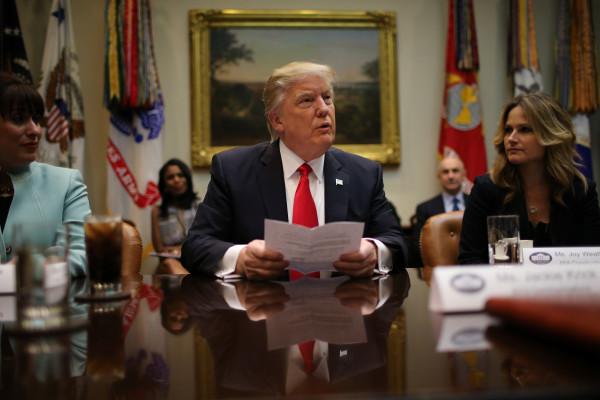

Donald Trump has campaigned as an enemy of free trade, immigration, regulation and abortion rights. He regards Islamic terrorism as the US’s foremost danger, and has little time for the proprieties of Congressional behaviour.
President Trump won an election on these foundations, and his energetic pursuit of them as president is delighting his supporters.
Finding the jobs
The president also has to find them jobs, but that will not be so easy. Good manufacturing jobs have been disappearing in the US (as in the UK) over the past three decades, since mechanisation has brought about increased productivity but fewer workers, as well as a shift to service jobs, whether that be highly paid software engineers or poorly paid carers, to ageing populations.
But as a businessman himself, and with many members of his cabinet having a similar background, Mr Trump must believe that ‘Yankee ingenuity’ still exists in the US rust belt. What it needs, he thinks, is hope and an injection of money. That will come from a vast Federal spending plan to rebuild the US’s rotting infrastructure.
That trillion-dollar deficit financing will have to be voted by Congress – something his predecessor was unable to achieve.
But President Trump – like John Kennedy and Franklin D Roosevelt before him – knows the secret of getting Congress to do what you wish is to ensure that your supporters are behind you. Donald’s Tweets, like Roosevelt’s radio fireside chats and Kennedy’s TV talks, will do exactly that. Congressmen don’t like voters complaining that they are not supporting their president.
Economic hell or purgatory?
Thus far, promises alone have sufficed to get the blood pumping in entrepreneurial veins. What will happen when actual money begins to appear?
Traditional economists and politicians are worried about inflation and overheating, and there are concerns that the Federal Reserve, now it has stopped supporting the stockmarket with its quantitative easing, will soon start rising interest rates.
As Ben Inker, co-founder and chief investment strategist of GMO, commented recently: “Will asset prices revert to valuation levels similar to historical norms, leading to bad returns for a while, but long-term returns similar to what investors have been trained to expect? Or have we seen a permanent shift such that asset-class valuations have risen permanently and long-term returns available from them have consequently fallen?
“Such a shift would be a profound problem for the basic rules of thumb used by almost all long-term investors, but in the shorter run this means returns will not be disastrously bad.
“The key metric I believe has driven market valuations upward in recent years, and could conceivably drive them right back down, is short-term interest rates.”
Mr Inker continues: “Much of this comes down to a question of whether cash rates over the next 10, 20 or 50 years will look like the ‘old normal’ of 1-2 per cent above inflation, or whether they will look more like the average of the past 15 years of about 0 per cent after lower inflation.
“The scenario where they average 0 per cent real is what we have referred to as ‘hell’, whereas the other scenario is ‘purgatory’.”
Invest where the action is
Purgatory is said to be finite, so investors need to take care with their US investments and watch what happens to interest rates. Table 1 shows those investment trusts with a minimum of 20 per cent of their portfolios invested in the US, reaching up to 100 per cent in the case of the US specialists.
These shares can be purchased in the UK and in sterling, with exchange rate movements reflected in the share price. Brexit is almost certain to continue to drive down sterling against the US dollar.
Appreciating the statistics
The table has key lessons for investors. The effect of a sharp fall in capital values on compounded returns is clearly shown. With only two exceptions, every company shows much better returns over five years than across 10, and the reason is the financial crisis of 2007/08.
Another lesson is that immediate income comes at a price – the returns of those investment firms promising equity income have generally underperformed those trusts with no such constraint.
A more valuable insight is, perhaps, the outperformance of US smaller firms. Theoretically, smaller firms should be able to grow faster than those that are already well established. But, historically, in a world of global trade, giants such as Procter & Gamble, Johnson & Johnson, Heinz and Nestlé have been safer and more profitable holdings for investors.
Yet there are signs that such large firms have exhausted the cost opportunities of size, and are beginning to suffer from the managerial complexities of spread and reach.
It is becoming difficult to compete with local firms, able to poach ideas from their global competitors while responding more quickly to growing nationalism and local fads.
Key to the future
Another consideration is technology – manufacturing and medical. These are US specialities, albeit among companies likely to be smaller in size than those typically found in US funds.
Baillie Gifford’s two technology trusts: Scottish Mortgage and Edinburgh Worldwide, have done well in the past five years, as have F&C Asset Management and JP Morgan Asset Management’s smaller company portfolios.
Importantly, and despite the events of 2008, these trusts’ 10-year records all show worthwhile returns in a world of zero rates and no inflation.
Equity investing is about purchasing income, so it is best to let managers be unconstrained. If this is seen as too risky to sleep well at night, then try larger and more diversified managers such as Witan.
Check the objectives of board and managers are aligned by reading the annual report and accounts, then invest slowly over a 12-month period. Let ‘the Donald’ prove himself first.




